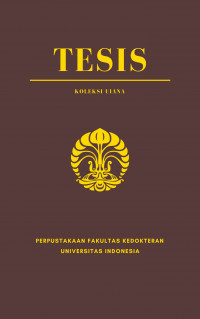Tesis
Perbandingan Efektivitas High Flow Nasal Cannula dan Continuous Positive Airway Pressure pada Anak dengan Gagal Napas Hipoksemia Akut = Comparison of Efficacy between High Flow Nasal Cannula and Continuous Positive Airway Pressure in Children with Acute Hypoxemic Respiratory Failure.
Latar Belakang Gagal napas hipoksemia terjadi akibat kegagalan paru sehingga terjadi gangguan ventilasi perfusi. Intubasi dengan endotracheal tube dan pemasangan ventilator mekanik dapat menjadi penyelamat nyawa pada keadaan gagal napas, namun banyak laporan mengenai komplikasi terkait prosedur tersebut. Non-invasive respiratory support yang banyak dipakai saat ini adalah suatu metode pemberian bantuan napas mekanik dengan memberikan tekanan positif tanpa intubasi. High flow nasal cannula (HFNC) dan continuous positive airway pressure (CPAP) termasuk dalam golongan ini. Penelitian HFNC pada gagal napas hipoksemia akut masih terbatas. Penelitian ini adalah penelitian yang membandingkan efektivitas HFNC dengan metode lain pada pasien gagal napas hipoksemia akut. Tujuan Mengetahui efektivitas HFNC dibandingkan dengan modus CPAP pada anak dengan gagal napas hipoksemia akut. Metode Uji klinis acak terkontrol dilakukan pada anak gagal napas hipoksemia akut (saturasi oksigen < 90%) di Rumah Sakit Cipto Mangunkusumo (RSCM). Pasien yang memenuhi kriteria pemilihan subjek dilakukan randomisasi dan terbagi ke dalam kelompok HFNC atau intubasi dengan modus CPAP. Pemeriksaan gas darah dan pengambilan parameter klinis (saturasi oksigen, laju napas, laju nadi), skor nyaman dan lingkar perut sebagai data dasar dan dalam 1 jam pasca-pemasangan alat. Hasil Dari 22 subyek penelitian, kelompok HFNC dan CPAP menunjukkan perbaikan parameter klinis dan skor nyaman yang bermakna pada 1 jam pasca pemasangan alat (p < 0,05). Terdapat peningkatan rasio PF (PO2/FiO2) pada kedua kelompok dengan hasil yang bermakna pada kelompok HFNC (p = 0,023). Tidak ada perbedaan efektivitas antara HFNC dan CPAP. Penelitian ini tidak menemukan adanya efek samping aerofagi dan rerata priming enteral diberikan pada hari kedua pasca-pemasangan HFNC. Kesimpulan HFNC sama efektif dengan CPAP dalam memperbaiki parameter klinis dan rasio PF (PO2/FiO2) pada anak dengan gagal napas hipoksemia akut. HFNC dan CPAP dapat memberikan kenyamanan dalam pemakaiannya dan tidak menimbulkan efek samping.
Kata kunci: gagal napas; hipoksemia akut; HFNC; CPAP; pasien anak
Background Hypoxemic respiratory failure is a condition that occurs due to pulmonary failure, resulting in ventilation perfusion disruption. Intubation with an endotracheal tube and installation of mechanical ventilator can be lifesaving, but there are many reports due to its complications. Non-invasive respiratory support that frequently use nowsday, provides mechanical breathing assistance without intubation. High flow nasal cannula (HFNC) and continuous positive airway pressure (CPAP) belong to this group. Only limited studies regarding the use of HFNC in children with acute hypoxemia and no study has been done in Indonesia, therefore this research is conducted to see the efficacy of HFNC in acute hypoxemic respiratory failure pediatric patient compared to CPAP mode. Aim To compare the efficacy of HFNC and CPAP in children with acute hypoxemic respiratory failure. Methods A randomized controlled trial study of children with acute hypoxemic respiratory failure (oxygen saturation less than 90%) was conducted in Cipto Mangunkusumo Hospital. Patients who met the inclusion criteria were randomized and divided into HFNC or intubated with CPAP mode group. Clinical parameters (oxygen saturation, respiratory rate, and pulse rate), comfort score, abdominal circumference, and blood gas analysis were evaluated as initial data dan within one hour after device installation. Result Out of 22 subjects, HFNC and CPAP group showed significant improvement in clinical parameters and comfort score within one hour after device installation (p < 0,05). There was an increase of PF ratio (PO2/FiO2) in both groups with significant result for HFNC group (p=0,023). No difference in efficacy between HFNC and CPAP group. There were no adverse events of aerophagia and nasal mucosal irritation in HFNC group. Enteral feeding started in day two after administration HFNC. Conclusion HFNC has the same efficacy as CPAP in the improvement of clinical parameters and PF ratio (PO2/FiO2) in children with acute hypoxemic respiratory failure. Both devices comfort for the patients.
Key words: respiratory failure; acute hypoxemia; High Flow Nasal Cannula; Continuous Positive Airway Pressure; pediatric patients
- Judul Seri
-
-
- Tahun Terbit
-
2020
- Pengarang
-
Niken Wahyu Puspaningtyas - Nama Orang
Rismala Dewi - Nama Orang
Antonius H. Pudjiadi - Nama Orang - No. Panggil
-
T20527fk
- Penerbit
- Jakarta : Sp-2 Ilmu Kesehatan Anak., 2020
- Deskripsi Fisik
-
xvi, 66 hlm. ; 21 x 30 cm
- Bahasa
-
Indonesia
- ISBN/ISSN
-
-
- Klasifikasi
-
NONE
- Edisi
-
-
- Subjek
- Info Detail Spesifik
-
Tanpa Hardcopy
| T20527fk | T20527fk | Perpustakaan FKUI | Tersedia |


Masuk ke area anggota untuk memberikan review tentang koleksi